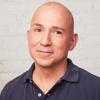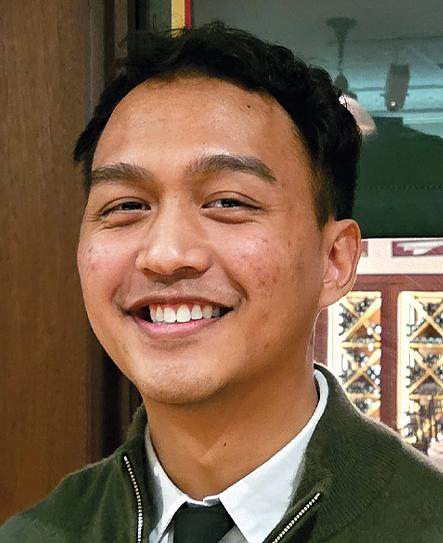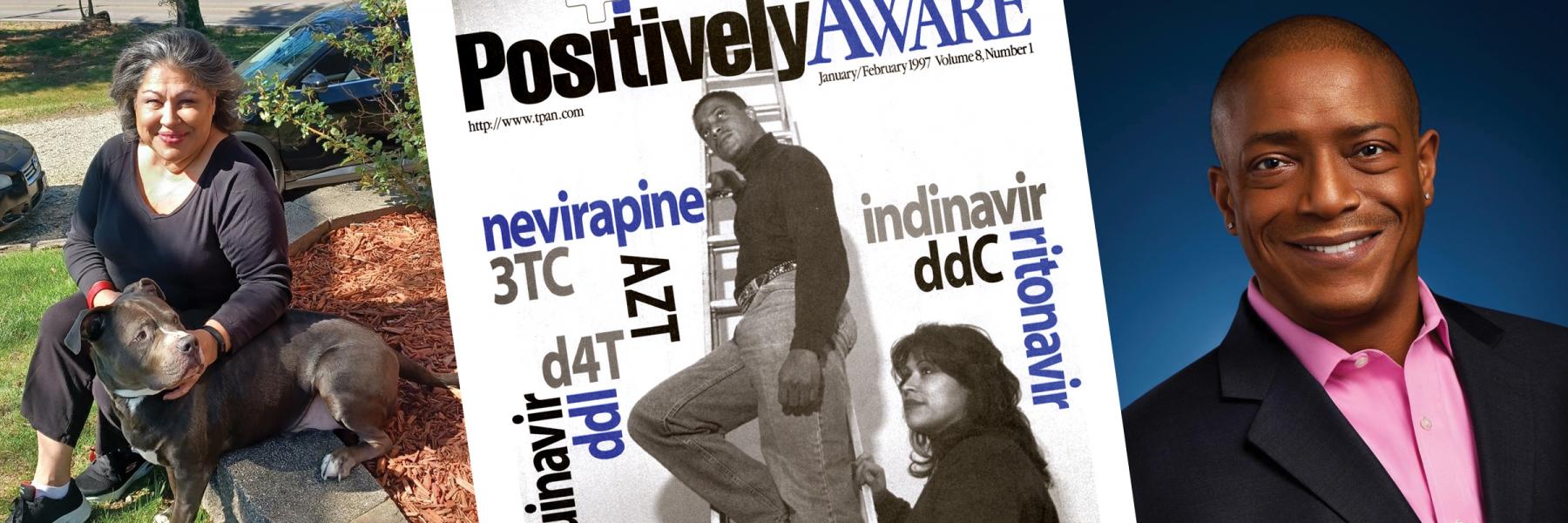
Living with HIV was very different in 1997, the year when the Positively Aware annual HIV Drug Guide was first published. It was also early days for Sylvia O’Shaughnessy and Sanford E. Gaylord in their journey living with HIV when they agreed to be photographed for the cover of that first drug guide. (The third person on the cover was an HIV-negative model.)
Sylvia
“I wanted to educate everybody,” Sylvia O’Shaughnessy says. “I especially wanted to educate women. I had this burning desire to let people know that you could live with this disease and still stay healthy. My thing was, don't stop living. A lot of us are alive, but we're not living. When you get diagnosed with HIV, that's basically what happens—you stop living, you're just alive.”
Her children were supportive of her taking part in the cover shoot. It was in contrast to when O’Shaughnessy initially disclosed her status to her own parents. “She was very casual about it, but when I wet my hands and dried them with a towel, my mother made sure to immediately put the towel in the washing machine,” she says. “The fact of the matter is back then I couldn't even blame her because I myself didn't know. I didn't know there was information out there. It was the early ’80s; we didn’t really have anyone to talk to.”
Born into a Puerto Rican family (Sylvia is the younger sister of POSITIVELY AWARE associate editor Enid Vázquez), there were cultural issues as well. “As a Hispanic, we don't take our issues outside of our family,” she says. “So, I didn't know of anything that was out there. At first it hurt. It was such a big hurt to see my mother doing this and to see how my family was walking on eggshells around me. But as the years went by, my parents grew to understand. My father started watching every news story about it. Back then there were a lot of stories about AIDS, they didn't even say HIV. My dad would tell my mother what he learned, and they started educating themselves from what my father was watching and reading. After a while, the tension that was at the beginning, was no longer there.”
In the early days of the AIDS epidemic, HIV was usually considered a death sentence. “I sat around for years waiting to die because in the beginning, the doctor told me that in three months to six months, I was going to be gone and to put my kids up for adoption and get my affairs in order,” she says. “I’ll never forget that, the fear that they put in me with those words, the anger that I got towards God.”
It challenged her faith. “How the hell do we have this loving God who would punish me—what did I do?” she says. “I couldn't understand. So, I became an atheist.”
But as she lived beyond her initial prognosis, she came to another realization. “Doctors have an ‘MD’ after their name, but they’re not God, so I let go of that fear. I lived past six months and then I lived past a year, so I started negotiating with God. Let me live to see my daughter turn 12 years old, let me live to see my son go to kindergarten. I kept bargaining for years. Today, I say, Jesus Christ, you don't want me? What's taking you so long? Old age has crept up on me, which I wasn't expecting. I was 23 when I was diagnosed; I didn't think I was gonna see 24. I'm past 60 now. I got diabetes, high blood pressure, high cholesterol. I'm going through a lot of old age shit. I never thought I would live this long and go through what I'm going through now.”
Still, she reflects on what keeps her going. In addition to her three adult children, she has 11 grandchildren and three great-granddaughters. “There is so much that keeps me alive,” O’Shaughnessy says, “I am grateful. I always learned the hard way. If things are too easy, you just don't know better and you take it for granted. HIV was the hard way of learning that I have to be living, not just be alive. I learned to live. Today, I do arts and crafts. I refinish and redo tables and furniture and paint them. I create. I enjoy life. I wake up every morning thanking God for another day of life. There are times when I'm really ill and really, really down. I look up and say, God, what are we waiting for? But I’m still here because I still got something else to learn; that's how I look at it. There's still something else for me to do.”
Sanford
For Sanford E. Gaylord, being photographed for the drug guide cover was a continuation of his journey with HIV.
“I remember that very fondly because I worked at Test Positive Aware Network [later known as TPAN, former publisher of POSITIVELY AWARE],” he says. “I had gone from attending support groups to being a volunteer to working at the organization. I was actually quite humbled and excited to be asked to be in it. It came at a time when I was in the greatest amount of fear about living with HIV—who would touch me, who would love me, who would even want to be around me if they knew I was living with HIV? For me to literally come out of that closet, as well as coming out of the gay closet, I came out of them both at the same time. It was empowering because I no longer had to live in fear. I was able to do what others had done for me. They showed that you can live and thrive with HIV. This was my way of paying it forward. It would be a great opportunity for folks to see other folks of color, particularly those of African descent.”
Like O’Shaughnessy and many other people diagnosed in the ’80s and ’90s, Gaylord was told he did not have much time. “We were preparing for our deaths,” he says. “I was living out my dream. I was going to college thinking I wouldn't get my degree before I die. I was told to get my affairs in order, that I wouldn't live to be 30. I was 32 at that time, and was waiting to die. That’s when things slowly started to change.”
He pointedly remarks that he has outlived the doctor who had given him his initial grim prognosis. Gaylord has gone on to pursue careers in writing and acting, receiving recognition for his work. “I wrote many articles for the LGBT press, becoming an award-winning writer writing about being a Black gay man living with HIV in 1998,” he says. “I’ve had the opportunity to appear in three documentaries and three films. I’ve worked from community-based organizations to the United States Department of Health and Human Services. It's been an incredible journey.”
Still, surviving amidst the loss of so many friends and loved ones has left him with mixed emotions. “To still be here dancing upon the earth instead of lying under it, I feel beyond privileged and blessed to still be here,” he says. “I still have an enormous amount of guilt that I feel because I'm still here. I'm still triggered because we just went through COVID, which unearthed things that I had compartmentalized.
“I think that it's just become more manageable, to be bluntly honest,” he admits. “I have learned to make new friends. I have learned to create chosen family. I didn't think that I'd be able to do that 26 years ago when I lost my best friends, one to cytomegalovirus, another one had PCP [pneumonia] and then TB. Imagine losing the people who are your rock when you've already been disowned by your family because you chose to acknowledge that yes, I am. I had so many losses that I started to compartmentalize and didn't make new friends. I can make friends now. It's not easy, but I'm managing it better. I know that because I'm here, I'm charged with telling my story.”
Asked what he would tell his younger self from the photo shoot 27 years ago, Gaylord pauses then says, “Stay curious, ask questions. There isn't much I can tell my younger self; I just needed to fucking learn. I had too much mouth. Way too much mouth. I would say, be quiet a bit more and listen. Process a little bit more. You are not a biohazard. Allow yourself to be loved. There is life after diagnosis. If you claim it.”

A pharmacy student gains an appreciation for HIV treatment
Justin Chhoeun, a second-year pharmacy student at the University of Illinois at Chicago (UIC), was born the year POSITIVELY AWARE’s annual HIV drug guide was first published. Pharmacists can play an important role in a person’s health, he says, which is one reason why he’s interested to learn about HIV treatment.
—Rick Guasco
What got you interested in specializing in HIV?
I became interested in HIV after being on rotation at the infectious disease clinic at UIC. My pharmacist preceptor (Rodrigo Burgos, PharmD, AAHIVP) specialized in HIV and made an originally difficult topic easier to understand. After working with him for the semester and seeing the impact and connections he made with his patients, I slowly gained an appreciation for the work that goes into caring for this patient population. Although I did love patient interactions, understanding the intricacies of treatment regimens was definitely a huge player in why I am so interested in HIV.
Is there anything about HIV or HIV treatment that you didn't know about that surprised you?
One of the things that most surprised me about HIV treatment was how far we have come. First-line treatment is one pill a day compared to the regimens in the past. Even if patients develop resistance, there are still so many drugs up our sleeves that we can still get patients to live normal lives. Growing up as a gay man, I had always thought HIV diagnosis would be a death sentence but it just really is not the case anymore with today's innovations. It is one of my favorite things I learned about HIV!
What are some of the key issues or factors you are discovering as you're studying?
One research question I discussed with my preceptor was how to determine the value of pharmacist interventions in an HIV clinic. Although I am biased and can see the direct impact my pharmacist makes on patients' lives, how can we quantify these interventions so that institutions and clinics can also see this value? Not only does it answer the question of “what is the value of a pharmacist in this setting?” but also it paves a path to mobilizing more support for patients living with HIV.
What do you see as your role in the life of a person living with HIV or within the healthcare system?
It's hard to say what I want my role to be when it comes to HIV, but I do know that increasing patient access to medications has been one of my long-running thoughts. There is a population that cannot afford the medications needed to treat this condition and I wish there was more I could do as a future pharmacist to change this.


